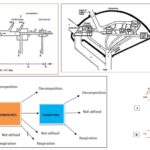What are the major transport mechanisms for CO2? Explain.
What are the major transport mechanisms for CO2? Explain.
Please login to submit an answer.
Carbon dioxide travels in three principal forms; on average 60–70 % moves as bicarbonate ions, 20–30 % as carbamino‑compounds, and 5–10 % simply dissolves in plasma.
Bicarbonate route
CO₂ diffuses from tissues into red blood cells and, under carbonic anhydrase, hydrates to carbonic acid; this instantly dissociates into HCO₃⁻ and H⁺.
HCO₃⁻ exits the erythrocyte via the Band 3 Cl⁻/HCO₃⁻ exchanger, while Cl⁻ enters (chloride shift), maintaining electroneutrality; the reverse shift in pulmonary capillaries reforms CO₂ for exhalation
Proton buffering by deoxy‑hemoglobin prevents large pH swings and drives further CO₂ uptake; oxygenation in lungs releases H⁺, facilitating CO₂ release (Haldane effect).
Carbamino‑compound route
CO₂ binds reversibly to terminal α‑amino groups of globin chains, forming carbaminohemoglobin and minor carbamino‑proteins in plasma.
Affinity rises when O₂ tension falls, so venous blood carries more carbamino‑CO₂ than arterial—another facet of the Haldane effect that augments total CO₂ carriage from active tissues.
Unloading in the lungs is rapid because O₂ binding shifts hemoglobin to its R‑state, displacing CO₂ back to plasma and finally to alveolar air.
Dissolved CO₂ route
Henry’s law allows a small but physiologically important fraction of CO₂ to remain in true solution; its partial pressure gradient (≈45 mm Hg in tissues to ≈40 mm Hg in alveoli) drives bulk diffusion.
Although only 5–10 % of total load, this fraction is crucial for minute‑to‑minute regulation because chemoreceptors monitor arterial pCO₂, not total CO₂ content.
Integrated significance
Rapid enzymatic conversion, chloride exchange, hemoglobin buffering, and the Haldane‑Bohr interplay cooperatively raise the CO₂‑carrying capacity of blood roughly twentyfold above simple dissolution alone—ensuring efficient clearance of ~200 mL CO₂ produced per minute at rest.
- Share on Facebook
- Share on Twitter
- Share on LinkedIn
Helpful: 0%




